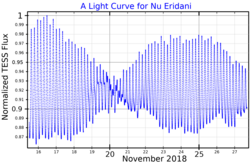| Observation data Epoch J2000.0 Equinox J2000.0 (ICRS) | |
|---|---|
| Constellation | Eridanus |
| Right ascension | 04h 36m 19.141s[2] |
| Declination | −03° 21′ 08.86″[2] |
| Apparent magnitude (V) | +3.930±0.023[3] |
| Characteristics | |
| Spectral type | B1.5 IV[4] |
| U−B color index | −0.879±0.007[3] |
| B−V color index | −0.210±0.009[3] |
| Variable type | SPB and Beta Cephei[5] |
| Astrometry | |
| Radial velocity (Rv) | 14.9[6] km/s |
| Proper motion (μ) | RA: +1.53[2] mas/yr Dec.: −5.01[2] mas/yr |
| Parallax (π) | 4.83 ± 0.19 mas[2] |
| Distance | 680 ± 30 ly (207 ± 8 pc) |
| Absolute magnitude (MV) | −2.84±0.15[4] |
| Details[4] | |
| Mass | 9.3±0.3 M☉ |
| Radius | 6.2±0.5 R☉ |
| Luminosity | 7,943 L☉ |
| Surface gravity (log g) | 3.85±0.05 cgs |
| Temperature | 22,000±250 K |
| Rotational velocity (v sin i) | 26±2 km/s |
| Other designations | |
| Database references | |
| SIMBAD | data |
Nu Eridani (ν Eri) is a star in the constellation Eridanus. It is visible to the naked eye with an apparent visual magnitude of 3.93.[3] The distance to this star is roughly 520 light years, based upon an annual parallax shift of 0.00625 arcseconds.[2] If the star were 33 ly (10 pc) from the Sun, it would be the brightest star in the night sky with an apparent magnitude of −2.84.[4] (Currently, the brightest star is Sirius at magnitude −1.46.)

This is a B-type subgiant star with a stellar classification of B1.5 IV.[4] It is a hybrid pulsator variable, lying as it does on the overlapping instability strips for Beta Cephei variables and slowly pulsating B-type stars.[5] The star shows at least fourteen pulsations frequencies, with nine that also display radial velocity variations.[8] It has about nine times the mass of the Sun and six times the Sun's radius. Nu Eridani shines with 7,943 times the solar luminosity from its outer atmosphere at an effective temperature of 22,000 K.[4]
References
- ^ "MAST: Barbara A. Mikulski Archive for Space Telescopes". Space Telescope Science Institute. Retrieved 19 August 2022.
- ^ a b c d e f van Leeuwen, F. (2007), "Validation of the new Hipparcos reduction", Astronomy and Astrophysics, 474 (2): 653–664, arXiv:0708.1752, Bibcode:2007A&A...474..653V, doi:10.1051/0004-6361:20078357, S2CID 18759600.
- ^ a b c d Nieva, M.-F. (February 2013), "Temperature, gravity, and bolometric correction scales for non-supergiant OB stars", Astronomy & Astrophysics, 550: A26, arXiv:1212.0928, Bibcode:2013A&A...550A..26N, doi:10.1051/0004-6361/201219677, S2CID 119275940.
- ^ a b c d e f Nieva, María-Fernanda; Przybilla, Norbert (2014), "Fundamental properties of nearby single early B-type stars", Astronomy & Astrophysics, 566: A7, arXiv:1412.1418, Bibcode:2014A&A...566A...7N, doi:10.1051/0004-6361/201423373, S2CID 119227033.
- ^ a b Moravveji, Ehsan (January 2016), "The impact of enhanced iron opacity on massive star pulsations: updated instability strips", Monthly Notices of the Royal Astronomical Society: Letters, 455 (1): L67–L71, arXiv:1509.08652, Bibcode:2016MNRAS.455L..67M, doi:10.1093/mnrasl/slv142.
- ^ Wilson, R. E. (1953), "General Catalogue of Stellar Radial Velocities", Carnegie Institute Washington D.C. Publication, Carnegie Institute of Washington D.C., Bibcode:1953GCRV..C......0W.
- ^ "nu. Eri". SIMBAD. Centre de données astronomiques de Strasbourg. Retrieved 2016-11-03.
- ^ Daszyńska-Daszkiewicz, J.; Walczak, P. (March 2010), "Complex asteroseismology of the β Cep/slowly pulsating B-type pulsator ν Eridani: constraints on opacities", Monthly Notices of the Royal Astronomical Society, 403 (1): 496–504, arXiv:0912.0622, Bibcode:2010MNRAS.403..496D, doi:10.1111/j.1365-2966.2009.16141.x, S2CID 118430678.

